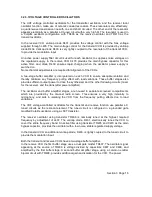
an amplitude limiter stage. Following the limiter the signal is low pass filtered prior to
modulating the transmit VCO. Provision is made to combine microphone and signalling audio.
3.1.3
Synthesizer
The frequency synthesizer provides the functions of excitation for the transmitter power
amplifier, and the receiver first local oscillator. A single phase locked loop principle is used
with synthesis at the required final frequency. The phase locked loop comprises the transmit
and receive VCOs, a prescaler/divider, programmable divider and phase comparator,
reference oscillator,and loop low pass filter. The action of the loop is to phase lock the VCO
frequency to the stable reference frequency which is derived from a crystal oscillator.
The synthesizer is reprogrammed to a new frequency by a serial sequence of data commands
to the programmable divider IC, this data is latched in the IC. For frequency modulation in
transmit mode, both the transmit VCO and the synthesizer reference oscillator have
modulation applied.
3.1.4
Microprocessor Control
A single chip 8-bit CMOS microprocessor forms the basis of the computer control circuitry.
Within this device is a masked program read only memory. This program performs the
generation and detection of selective call tone sequential signalling, as well as the operational
characteristics of the selcall system response. In addition to this, other major functions include
programming of the synthesizer, controlling the display of LCD information, controlling the
receiver
audio
mute
and
transmit
microphone
mute,
monitoring
the
front
panel
buttons,controlling CTCSS and reverse tone burst signalling, and performing the task of
programming and reading the electrically erasable memory.
The electrically erasable memory contains the user customizable information, which includes
features such as channel frequency, signalling system requirement (toneset, code, system
response etc.), transmit limit timer value. This memory is programmed or read via the
microprocessor, from the microphone socket interface.
The microprocessor operates from an external 1'6MHz clock using a crystal oscillator. This
clock frequency is divided by an additional IC to provide a clock signal of 1 MHz for the
CTCSS option.
A latch is provided between the microprocessor and several controlled functions of the radio
transceiver. This latch provides a port expansion of the microprocessor and isolates some of
the more sensitive radio control interfaces from the microprocessor clock noise.
3.1.5
Signalling
Selective call tone frequency generation is performed in the microprocessor. A digital to
analog convertor provides a low distortion encode signal. Receiver demodulated selcall is
bandpass filtered before a zero-crossing detector. This circuit produces impulses at twice the
frequency of the demodulated selcall tones and provides a waveform suitable for processing
directly by the microprocessor.
Section 3 Page 3
















































